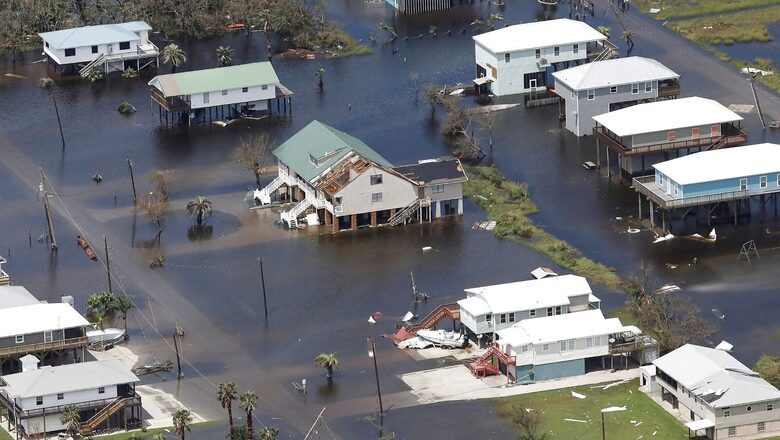
views
The message is loud and clear. 2021 was a clarion call for the world to sit up and take note of extreme weather events that seemed to set new records this year. From tropical storms and tornadoes to heatwaves and floods as well as dust storms, locust plagues and droughts, the year saw it all.
Even as the Covid-19 pandemic raged, world leaders met at Scotland towards the end of October for the COP26 climate summit. But after two years of preparation and 13 days of tough talks, they could not devise a proper plan to save the planet.
This was on the back of a report released by the Intergovernmental Panel on Climate Change (IPCC) in August that stated climate change is widespread, rapid, and intensifying, and some trends are now irreversible, at least during the present time frame.
Scientists said human-induced climate change was already affecting many weather and climate extremes in every region across the globe. They had also observed changes across the whole of Earth’s climate system; in the atmosphere, in the oceans, ice floes, and on land.
António Guterres, UN Secretary-General, said the IPCC report was nothing less than “a code red for humanity. The alarm bells are deafening, and the evidence is irrefutable”.
But even though US president Joe Biden re-entered the Paris agreement in the early days of his administration, the promises made were not met with any kind of action.
A report ‘Counting the cost: 2021, A year of climate breakdown’ by Christian Aid, a relief and development agency in Ireland, highlighted the 10 most financially devastating climate events of the year, from tropical cyclones in the United States, China and India to floods in Australia, Europe and Canada. According to the report, these were the most expensive events financially costing over $1.5 billion of damage.
Hurricane Ida in the US topped the list at $65 billion while the floods in Europe came second at $43 billion, the report stated. It also looked at five events carrying a lower financial cost but caused large-scale devastation
such as drought in Africa and Latin America and floods in South Sudan.
Here are some of the extreme weather conditions witnessed over the past year. These not only resulted in the loss of lives and property, but also painted a grim picture of a future riddled with more such events if the world does not act soon.
JANUARY
Snowfall in Madrid, Spain: A persistent blizzard blanketed large parts of Spain with an unusual amount of snow on January 9, killing at least four people and leaving thousands trapped in cars or at train stations and airports that suspended all services. The national weather agency said the snowfall in Madrid reached a level unseen in half a century. More than half of Spain’s provinces remained under severe weather alerts for Storm Filomena, seven of them at the highest level of warning.
Biden administration in US rejoins the Paris Agreement: On January 20, United States President Joe Biden rejoined the global effort to curb climate change, a cause that his predecessor Donald Trump had shunned over the past four years. The Paris accord, forged in the French capital in 2015, commits countries to put forward plans for reducing their emissions of greenhouse gases such as carbon dioxide, which is released from burning fossil fuels. As president, Donald Trump questioned the scientific warnings about man-made global warming, at times accusing other countries of using the Paris accord as a club to hurt Washington. The US formally left the pact in November.
Cyclone Ana, Fiji: Towards the end of the month, a cyclone that hit the Pacific nation of Fiji left one person dead, five more missing and thousands in shelters. Fiji Prime Minister Frank Bainimarama pointed to climate change as a cause of recent deadly storms. Fiji was still recovering from an even more powerful cyclone that hit in December 2020. That storm, Cyclone Yasa, killed four people, with a fifth person listed as missing.
FEBRUARY
Texas deep freeze, US: A blistering cold spell hit normally warm Texas, killing 125 people in the state and leaving millions without power in freezing temperatures. Scientists have not reached a conclusion on whether climate change caused the extreme weather, but the warming of the Arctic is causing more unpredictable weather around the globe.
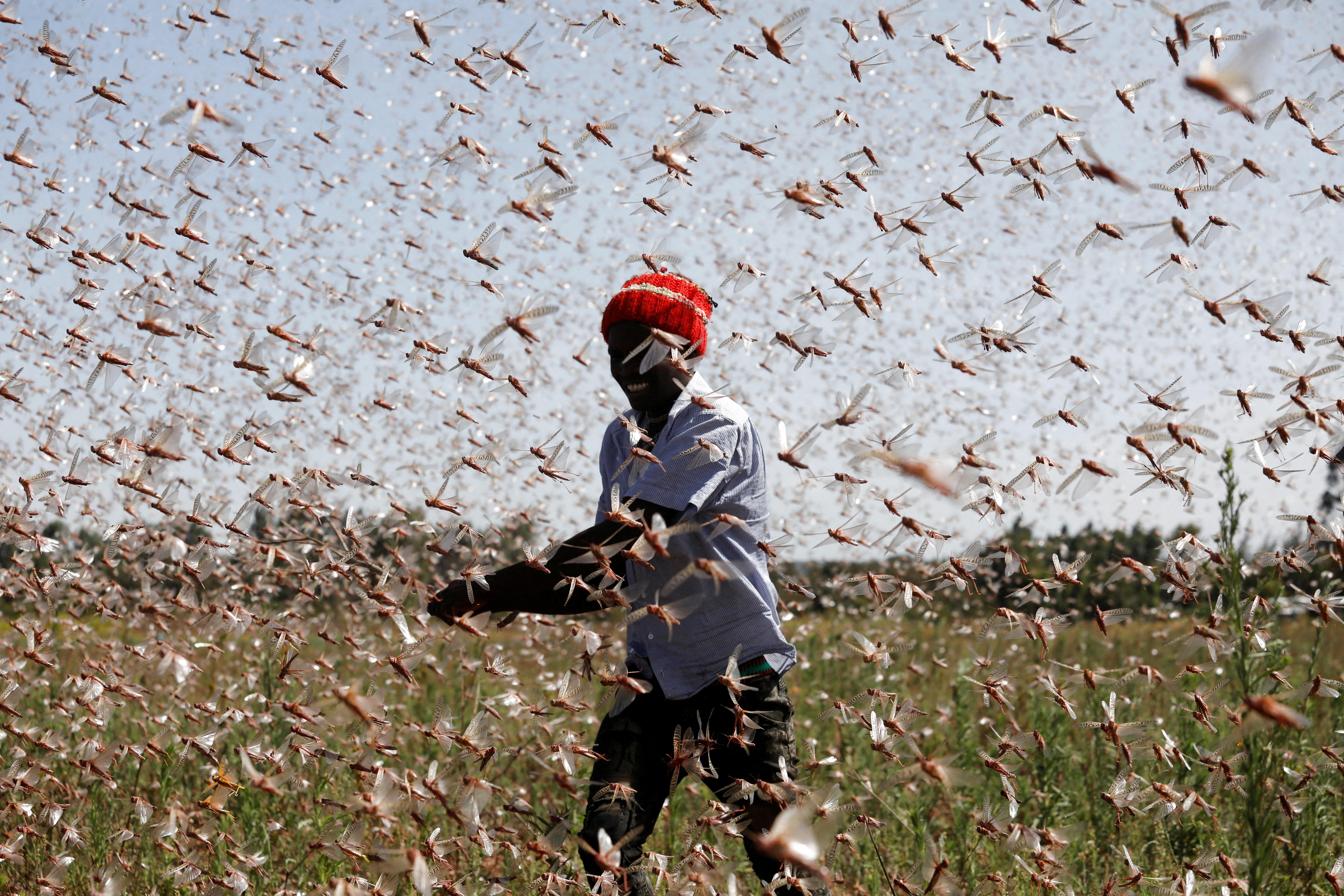
(A man tries to chase away a swarm of desert locusts away from a farm, near the town of Rumuruti, Kenya, in February. Image: REUTERS/Baz Ratner)
Locust plagues, Kenya: Kenya and other parts of East Africa battled some of the worst locust plagues in decades, with the insects destroying crops and grazing grounds. Scientists said unusual weather patterns exacerbated by climate change created ideal conditions for insects to thrive.
MARCH
Dust storm, China: Beijing’s sky turned orange and flights were grounded during the Chinese capital’s worst sandstorm in a decade. Busloads of volunteers arrive in the desert each year to plant trees, which can stabilise the soil and serve as a wind buffer. Scientists predict climate change will worsen desertification, as hotter summers and drier winters reduce moisture levels.
Flooding, Australia: Heavy rainfall caused flooding in Australia’s most populous state New South Wales, forcing hundreds and thousands to evacuate their homes. A year ago, vast swathes of New South Wales had been charred by unprecedented wildfires following years of drought that gripped most of the state. Some of the same areas were now being inundated by one-in-50-year and one-in-100-year rain events.
APRIL
Tropical storm in Indonesia, East Timor: On April 5, a tropical cyclone caused torrential rains leading to multiple disasters on remote eastern Indonesian islands as well as in East Timor. Over 200 people were killed while hundreds were reported missing. Cyclone Seroja continued to affect the Southeast Asian nations for days and then moved south toward Australia. The cyclone caused mudslides as well as flash floods, and caused solidified lava to tumble down the slopes of Ili Lewotolok volcano and hit several villages. That disaster alone killed at least 67 buried under tons of solid lava. The lava was left after the volcano erupted in November.
Seroja damaged several towns on Australia’s western coast, shattering windows, snapping trees and knocking out power. It crossed the western Australia state coast south of the tourist town of Kalbarri with winds gusting up to 170 kmph. Around 70% of the buildings in the town were damaged. Such powerful cyclones are rare in subtropical Australia. Wind gusts recorded in Kalbarri and nearby areas were likely to have been the “strongest in more than 50 years”.
MAY
Cyclone Tauktae and Yaas, India: After Cyclone Amphan in 2020, another powerful cyclone that emerged in the Arabian Sea made landfall on India’s western coast on May 14. Cyclone Tauktae, the most powerful storm to hit the region in over two decades, came ashore in Gujarat with heavy rain, a battering storm surge and sustained winds of up to 165 kmph, as per the IMD. Over 170 people were killed and hundreds of thousands evacuated amid the raging Delta wave. In Maharashtra, capital Mumbai was lashed by heavy rain and strong winds. Rain due to the storm had already caused loss of lives in Kerala, Karnataka and Goa before it hit Gujarat. The western coast is no stranger to devastating cyclones, but changing climate patterns have caused them to become more intense, rather than more frequent. Amphan led to the loss of close to 100 lives in May 2020, and was the most powerful storm to hit eastern India in over a decade.
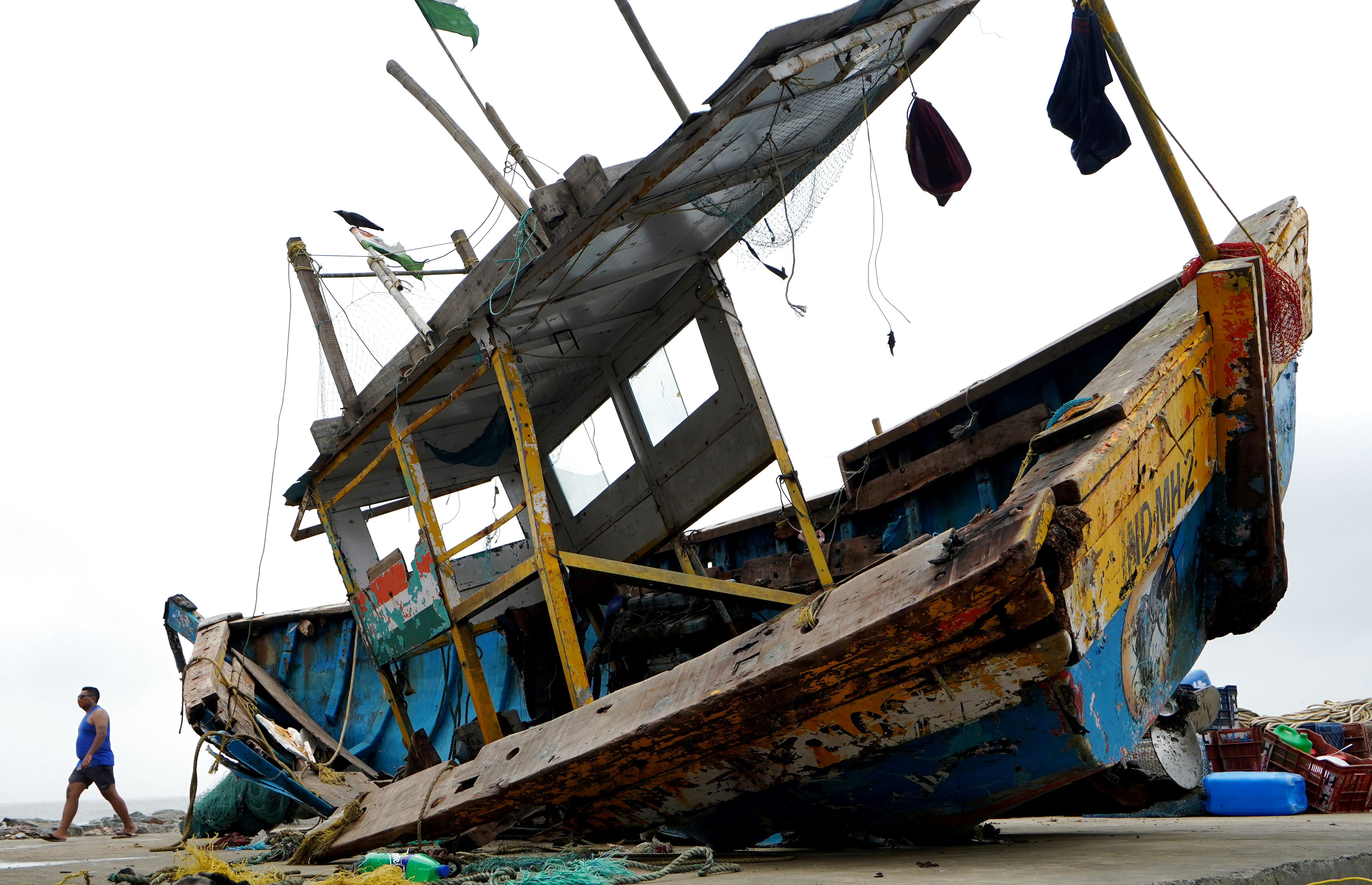
(A man walks past a damaged fishing boat on a shore after heavy winds caused by Cyclone Tauktae, in Mumbai. Image: REUTERS/Hemanshi Kamani)
Later, on May 26, Yaas hit the Odisha coast affecting the state and neighbour West Bengal with a wind speed of 130-140 kmph, flooding low-lying areas amid a storm surge. Together, the two cyclones were the fourth and fifth among 15 most destructive and expensive extreme weather events across the world, as per a report by Christian Aid.
JUNE
Drought in the US: Nearly all of the western United States was gripped by a drought that emerged in early 2020. Farmers abandoned crops, officials announced emergency measures, and the Hoover Dam reservoir hit an all-time low. By September, the US government confirmed that over the prior 20 months, the Southwest experienced the lowest precipitation in over a century, and it linked the drought to climate change.
Heat dome, Pacific Northwest: Hundreds died during a record-smashing heatwave in the US and Canadian Pacific Northwest, which scientists concluded would have been “virtually impossible” without climate change. Over several days, power lines melted and roads buckled. Cities, struggling to cope with the heat, opened cooling centres to protect their residents. During the heatwave, Portland, Oregon, hit an all-time record high of 46.7 degrees Celsius.
Heatwave, Moscow: Keeping up with the trend of unusually high temperatures, Russian capital Moscow were hit by hot temperatures. These were an all-time high for June since records started being kept. The mid-afternoon temperature of 34.8 degrees Celsius edged above 34.7 degrees recorded in 1901, according to Russia’s meteorological service. Researchers said the heat was due to a stationary anticyclone hovering over the European section of Russia. Moscow temperatures in June average about 22 degrees Celsius and many residents were unavailable to adapt, calling it “plain hell”.
JULY
Wildfires in Oregon and California, US: It was the year of wildfires, be it in the US or Europe, or even Russia. One of the largest wildfires of the year was the Bootleg Fire in Oregon, reported to have started in July 6 and contained completely by August 15. It was caused by a lightning strike and its impact was seen as far away as New York City and Boston, with vivid red sunrises and sunsets. Heat and smoke generated from the wildfire formed clouds that could be seen from miles. The fire burned through 4,13,765 acres and, at the its fastest, it grew at about 1,000 acres per hour in mid July.
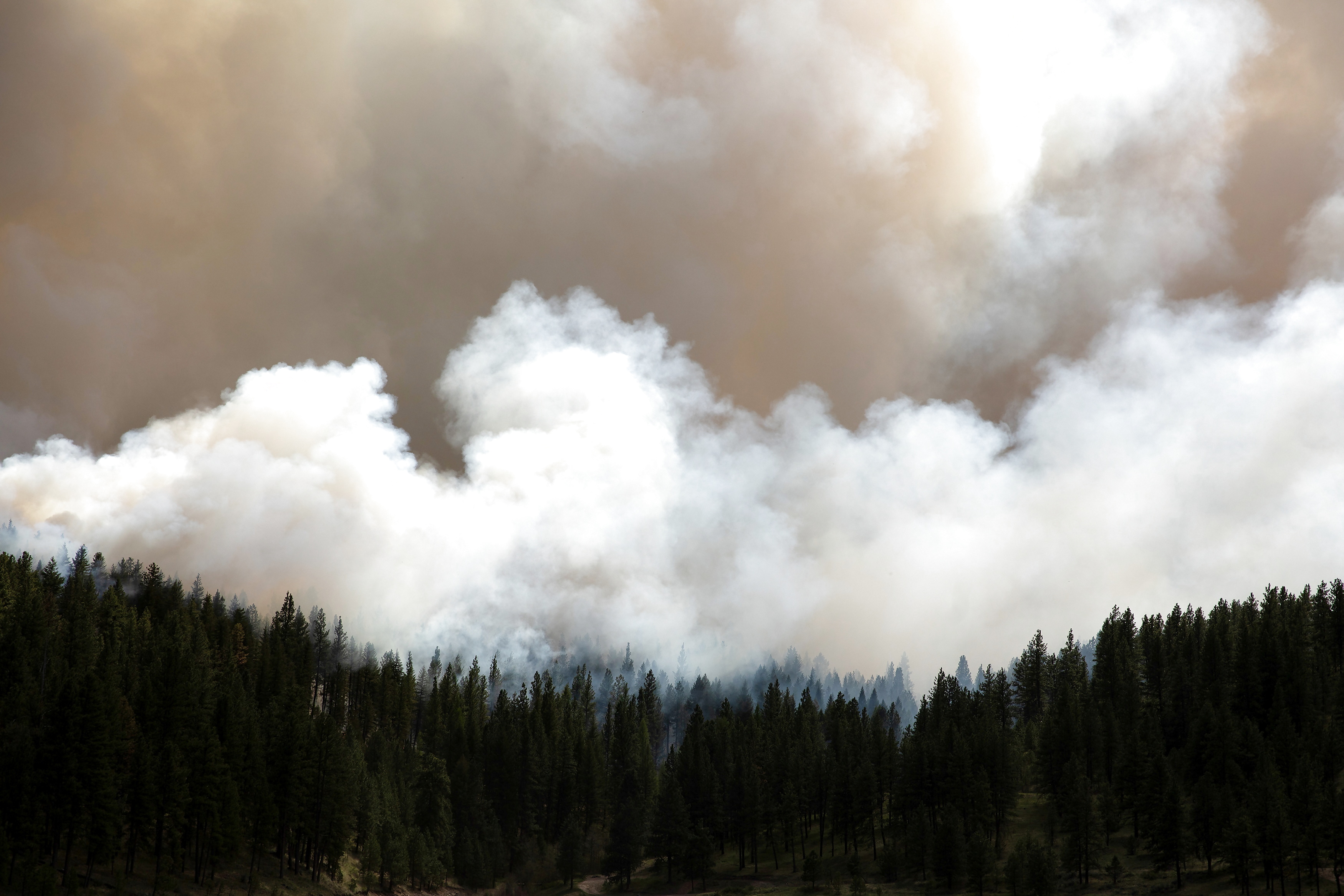
(Firefighters conduct a prescribed burn in the Wallowa-Whitman National Forest, Oregon. REUTERS/Ilie Mitaru)
The Dixie Fire, meanwhile, was the largest wildfire of the 2021 season in the US. It was reported to have started on July 13 and was completely contained on October 25. It burned through 9,63,309 acres, leaving behind a trail of destruction in several small towns. Smoke from the wildfire caused poor air quality across western US.
Scientists said growing frequency and intensity of wildfires were attributable to prolonged drought and increasing bouts of excessive heat from climate change.
Flooding across three continents: Three continents witnessed catastrophic flooding in the same month. Floods killed over 300 people in central China’s Henan province when a year’s worth of rain fell in just three days. In Europe, close to 200 were killed as torrential rains soaked Germany, Belgium and the Netherlands. Scientists said climate change had made the floods 20 per cent more likely to occur. Storm Elsa lashed New York City and New England with heavy rain and high winds, flooding streets, toppling trees and hindering some rail service. The winds from the storm were 85 kmph. The storm was preceded by a deluge that flooded some streets and subway stations in New York City.
AUGUST
Siberian forest fires: The month began with wildfires in Russia’s vast Siberia region, reported on August 7. In northeastern Siberia, 93 active forest fires burned across 1.1 million hectares of Sakha-Yakutia, making it the worst affected region of Russia. In recent years, Russia has recorded high temperatures that many scientists regard as a result of climate change. The hot weather coupled with the neglect of fire safety rules has caused a growing number of fires.
IPCC report a ‘code red’: Three months ahead of the United Nations Climate Change Conference COP26 in Glasgow, a report of an alarming nature was released by the Intergovernmental Panel on Climate Change (IPCC) on August 9. According to the report, scientists have found that climate change is widespread, rapid, and intensifying, and some trends are now irreversible, at least during the present time frame. Scientists further said they were observing changes across the whole of Earth’s climate system; in the atmosphere, in the oceans, ice floes, and on land. The UN Secretary-General António Guterres said the IPCC report was nothing less than “a code red for humanity. The alarm bells are deafening, and the evidence is irrefutable”, according to a press release issued by the United Nations.
Compiled by 234 scientists from 66 countries, the IPCC report highlighted that it was human influence that had caused global warming at an unprecendented rate in the last 2,000 years. Averaged over the next 20 years, global temperature is expected to reach or exceed 1.5 degrees Celsius. The scientists have warned that global warming of 2 degrees Celsius will be exceeded in the 21st century unless there is determined climate action.
Wildfires in Europe : In the Mediterranean, a hot and dry summer fanned intense blazes forcing thousands to evacuate in Algeria, Greece and Turkey. The fires, which killed two people in Greece and at least 65 in Algeria, struck amid an intense heatwave, with some places in Greece recording temperatures of over 46 degrees Celsius.
Rain on Greenland ice sheet: In what was a clear indicator of the risks of climate change, rain fell at the highest point on Greenland’s ice sheet — possibly for the first time. Danish scientists said this was most likely driven by climate change. The rain was observed for several hours on August 14 at a measuring post more than 3,000 m up on the sheet. For rain to fall, temperatures must be above or just slightly below zero, signalling the risk that rising temperatures pose to the world’s second-largest ice sheet after Antartica.
Researchers said this was an extreme event as it might not have happened before, adding that it was a probable sign of global warming. Temperatures have risen above freezing at the peak of the sheet only nine times in the past 2,000 years. Three of those events have been in the last 10 years — but on the previous two occasions, in 2012 and 2019, there was no rain. The rain comes after a summer in which northern Greenland has experienced record-setting temperatures of more than 20 degrees Celsius.
Hurricane Ida, US: The last climate event of the month, the tropical storm was the most destructive and expensive extreme climate event of the year in the world. Ida hit Louisiana as a Category 4 storm and killed close to 100 people. It caused an estimated $64 billion in damage. As the remnants of Ida moved inland, the heavy rains created flash flooding across the densely populated Northeast, vastly increasing the storm’s death toll.
Climate change is strengthening hurricanes, while also causing them to linger longer over land – dumping more rain on an area before moving on. Studies also suggest these storms are becoming more frequent in the North Atlantic.
SEPTEMBER
Volcano eruption, Spain: While many may not directly relate it to weather or even climate change, the eruption of a volcano on the Spanish island of La Palma destroyed hundreds of homes and large swathes of farmland. The resulting lava flow ended three months after it began on September 19. The Cumbre Vieja volcano did not directly cause injuries or deaths. But it spewed rivers of molten rock and ash plume containing toxic gases. It destroyed 1,345 buildings with the lava covering 1,250 hectares as it made its way to the Atlantic Ocean. Much of the property destroyed was banana plantations, La Palma’s main livelihood along with tourism. The damage from the eruption could exceed $1 billion. Even after its end on Christmas Day, the volcano will continue to release toxic gases for a long spell, which could pose a threat to the population.
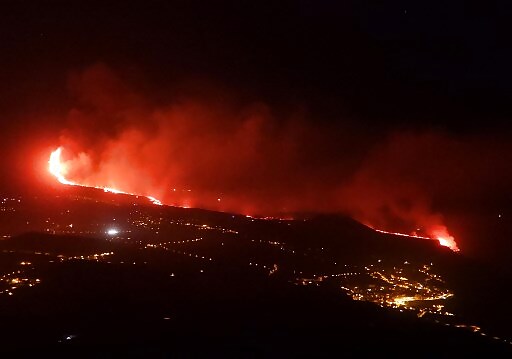
(The lava flow produced by the Cumbre Vieja volcano reaches the Atlantic ocean in Los Girres beach in Tazacorte on the Canary island of La Palma. Image: Sunsets Sweden/AFP)
OCTOBER
Floods in India and Nepal: In late-monsoon floods in India and Nepal, over 150 people were killed. Rains triggered flash floods, caused landslides, destroyed homes, crops and infrastructure and left thousands stranded. Experts said Nepal and India were “sandwiched” between the Covid-19 pandemic and worsening climate disasters, heavily impacting millions of lives and livelihoods.
NOVEMBER
Glasgow climate summit: With two months left for the year to end and preceded by numerous devastating climate events, world leaders met at the United Nations Climate Change Conference COP26. This was also on the back of the “code red” IPCC report, as countries met to take stock on action taken after the Paris agreement.
While Swedish activist Greta Thunberg, leading a 100,000-strong march through the streets of Glasgow, dismissed the meet as a “greenwashing festival”, experts hailed solid — even historic — advances in fighting the global warming threat. Compared to what came before, the first-ever call by 196 countries to draw down coal-fired power, or a promise to double financial aid each year — to roughly $40 billion — so poor nations can brace for climate impacts, are giant steps forward. But hard science diminishes much of the significance of the COP26 climate summit as the IPCC report found that global heating is certain to pass 1.5 degrees Celsius within a decade.
DECEMBER
Tornadoes, US: The storms in five states killed over 90 people. The National Weather Service recorded at least 41 tornadoes on December 10 and 11, including 16 in Tennessee and eight in Kentucky. Warm moist air screaming of spring and an eastbound storm front guided by a La Nina weather pattern spawned the tornadoes. Tornadoes in December are unusual, but not unheard of. But the ferocity and path length of these likely put them in a category of their own. Warm weather was a crucial ingredient in this tornado outbreak, but whether climate change is a factor is not quite as clear, experts said. Scientists said the science behind climate change affecting frequency of tornadoes was complicated. But atmospheric conditions that give rise to such outbreaks are intensifying in the winter as the planet warms, they added.
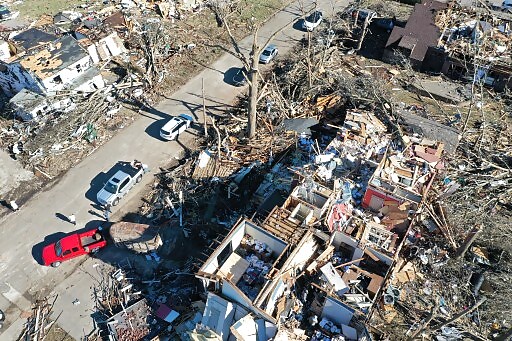
(A tornado ripped through Mayfield, Kentucky, on December 12. Multiple tornadoes touched down in several Midwest states late evening December 10 causing widespread destruction and leaving more than 80 people dead. Image: Scott Olson/Getty Images/AFP)
Typhoons, Philippines: The death toll due to the typhoon is over 300, with numerous missing. Several central provinces are struggling with downed communications and power outages and pleading for food and water. At its strongest, Typhoon Rai packed sustained winds of 195 kmph with gusts of up to 270 kmph before blowing out into the South China Sea. Typhoon Haiyan is one of the most powerful and deadliest typhoons on record, which devastated the central Philippines in November 2013.
(With inputs from PTI, AP, AFP and Reuters)
Read all the Latest News here













Comments
0 comment